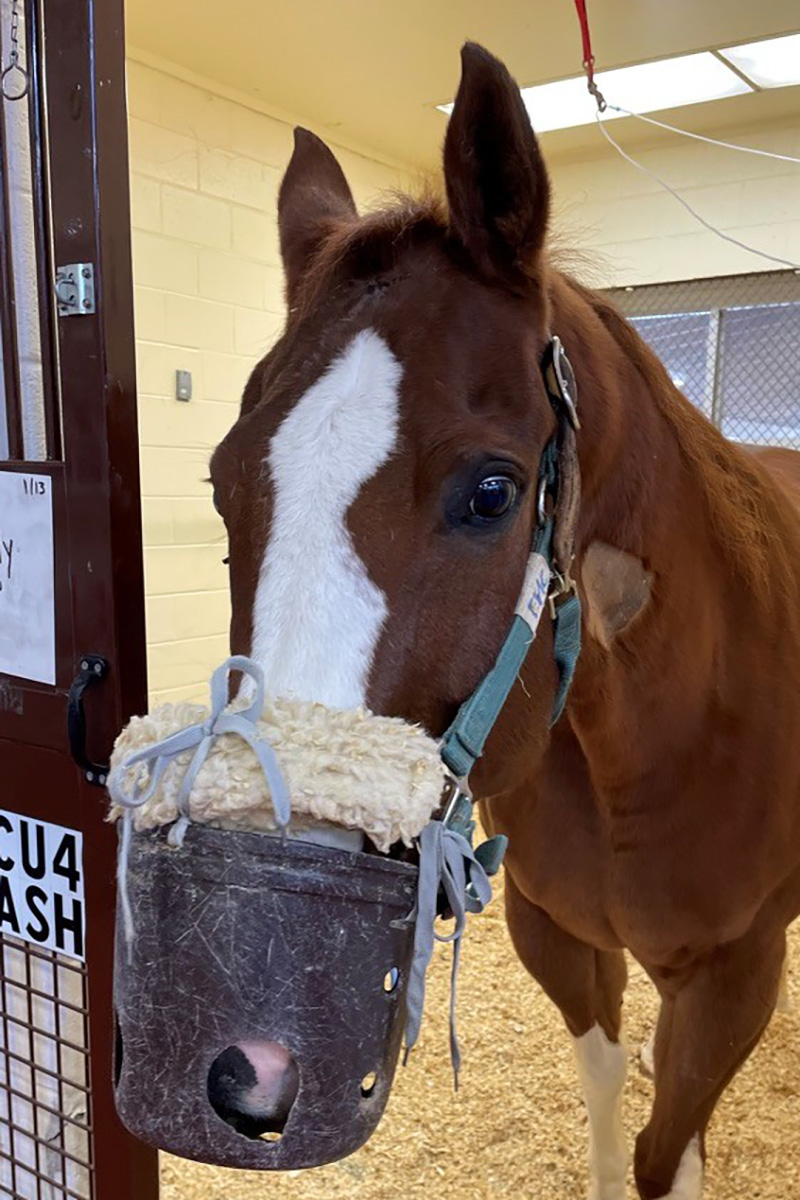Collaborative effort cures quarter horse Cody of guttural pouch mycosis
January 3, 2023

How Low Can You Go (Cody), an 11-year-old American quarter horse, owned by Jill Cotten, from Laurel, Maryland, visited the Marion duPont Scott Equine Medical Center (EMC) in mid-December 2021 for dysphagia – a rare condition affecting a horse’s ability to swallow.
Three days prior to being referred to the EMC for treatment, Suzanne Welker, DVM at Damascus Equine Associates in Mount Airy, Maryland, was called to examine Cody on the farm. At that time, feed material was coming out of both nostrils and Welker suspected an obstruction of the esophagus, but during her examination, no obstruction was encountered. Feed continued to appear in both of Cody’s nostrils over the next few days so he was referred.
When Cody arrived at the EMC on a Saturday morning in December 2021 for emergency treatment, Elizabeth MacDonald, clinical instructor of equine medicine noted that he was bright, alert, and obviously anxious, with green nasal discharge clearly visible in both of his nostrils. Cody was offered some feed, which he was able to masticate normally, but when he tried to swallow, he coughed and expelled the feed out of his nose and mouth.
Bloodwork was run in the center’s in-house laboratory and an upper airway endoscopy was performed. Endoscopy revealed food material throughout the larynx and pharynx, right laryngeal hemiplegia and Cody’s vocal cords were filled with fluid. He had feed material in his trachea.
The left guttural pouch was normal, but in the right guttural pouch was a large mycotic (fungal) plaque. The plaque was in close proximity to several nerve branches confirming that Cody’s dysphagia was a direct result of neurologic dysfunction of these nerves.
Cody was suffering from guttural pouch mycosis, a rare disease in horses that infects the lining of the guttural pouch and causes damage to the underlying nerves and blood vessels. Secondary nerve damage was preventing Cody from being able to swallow normally.
Cody’s treatment plan was aimed at reducing the size of the fungal plaque, intense supportive care, and tube feeding to provide sufficient nutrition. The goal was to support Cody while the mycotic plaque was treated. Only time would tell if Cody’s affected nerves would regain function.
MacDonald explained to Cotten that Cody’s prognosis for a full recovery from dysphagia was unknown, but often it is guarded. Cotten elected to continue his treatment – she just did not have the heart to give up on him. Cotten did not know if Cody would ever be able to eat again or eat enough to sustain himself, due to the nerve damage.

Cody was hospitalized and over the next few months, EMC faculty and clinical support staff battled with his fungal infection. The EMC surgical team removed the plaque with a CO2 laser. Topical treatment of the plaque was initiated along with anti-inflammatories, and other supportive care. A nasogastric tube (NGT) was placed through the nose to the stomach, allowing staff to feed Cody small amounts of soaked senior feed every four hours, day and night.
During the initial treatment, Cody had bouts of colic as he adjusted to a change in diet, he showed signs of acute kidney injury, which required treatment and monitoring, on top of regular endoscopy procedures to check his guttural pouch. EMC surgery and internal medicine teams worked collaboratively with clinical support staff to give Cody the best chance of recovery.
It was a very, very long road, with many hours of constant care and monitoring, not only by the center’s clinicians but by veterinary technicians and assistants, who monitored Cody’s progress and attended to his needs 24/7.
Several months after first arriving at the EMC for emergency treatment, the fungal plaque was completely gone and Cody was finally able to eat some food on his own. His ability to swallow gradually improved and he was allowed to go outside and graze for most of the day. Much to Cotten’s delight, Cody was finally ready to go home!
“We were very fortunate that Jill was so dedicated and gave us the opportunity to treat Cody,” MacDonald said. “There was a lot of uncertainty and we had complications along the way. After months of care, it was an exciting day when we saw Cody give us a hint that he may be able to swallow a little bit of food.”
An ecstatic Jill Cotten shared:
“Saving Cody's life was a huge effort by all and a true miracle, I believe due to everyone's hard work and dedication. It was dicey every step of the way, but he finally made it!
“Words are insufficient to express how grateful I am. I hope that by sharing his story and through the details of his history and medical care, that other horses in the future will be saved and an owner like myself will be spared the heartbreak of losing their beloved horse.
“I hope that his case will advance knowledge of what is possible and help equine veterinarians in the future continue to make advancements in treating this difficult infection and help advance the body of veterinary knowledge, so that other horses may be saved.”
MacDonald and Krista Estell, clinical associate professor of equine medicine, recently visited Cody at his home farm in Laurel, Maryland. After their visit, MacDonald commented: “It was a pleasure to see Cody again six months after his discharge and back to being a normal horse”.








